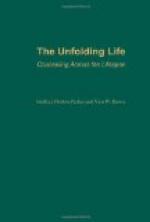There are certain modifications of earlier characteristics, which demand more than a passing notice, because they necessitate greater change in the methods of nurture.
ACTIVITY
Though the restlessness of the preceding period is still in evidence, more and more activity is becoming purposeful and willed. While the child continues to love activity for itself, he is more interested in what it will accomplish than formerly, but an end is not yet sufficiently attractive in itself to hold him to an unpleasant activity for its achievement. For example, he enjoys both the weaving and the basket, the pasting and the scrap-book, but if pasting and weaving were laborious and difficult, he would not voluntarily go through them to obtain the basket or the scrap-book.
It must be noted further, that activity still expends itself more readily in the realm of the physical than the mental, though there is increasing pleasure in the quest for knowledge, if wisely directed. The Sunday School is beginning to recognize what the day school has learned, that the child both enjoys and masters a lesson which can be approached through physical as well as mental avenues. In consequence, hand work is being introduced to aid in religious instruction, as manual work in the public schools for secular education, with most gratifying results in both cases.
THE SENSES
More skill, more accuracy and more discrimination characterize the work of the senses than in Early Childhood. The impressions are richer in detail and meaning, because of the increased knowledge possessed by the child. It is a commonplace that we receive from anything in proportion to what we bring to it. The ear of the musician hears in an orchestra what the child or the adult without the knowledge of music could never detect, because he listens with more than they. The child can see in a picture or circumstance, and hear in a conversation or a song, what once he could not, because he brings a larger experience to bear upon it. Criticism of others in the home, the lapses from Christ-like living, the scenes of the street, things pernicious as well as helpful have greater significance in character building than ever before. This gives still graver emphasis to the work of nurture in guarding these wide-open doorways to a hungry soul.
Growing out of the fact that the senses are the greatest source of information to the child’s mind, the method of teaching by means of objects has arisen. Rightly used, there is great value in this mode of instruction, but a serious perversion of its legitimate use has developed in connection with religious instruction of little children. Though the discussion of this may be a possible digression, it seems necessary in order to safeguard nurture from a mistake.




